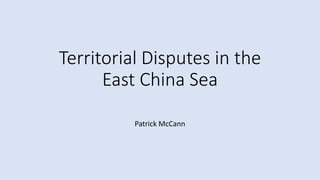McCann Undergraduate Research Conference Presentation
•Download as PPTX, PDF•
0 likes•8 views
The document summarizes the territorial dispute between China and Japan in the East China Sea over the Senkaku/Diaoyutai Islands. It notes that the islands are located in overlapping exclusive economic zones that have potential oil, gas, fishing, and shipping resources. While neither country wants open war, there is tension as domestic interest groups in both countries seek to exploit the contested natural resources, leading to increased economic and military aggression in recent years. The dispute has important implications for regional stability and U.S. interests in the Pacific.
Report
Share
Report
Share

Recommended
Recommended
SIBF Annual Summit 2013: Opportunities of the Present, Crises of the Future -...

SIBF Annual Summit 2013: Opportunities of the Present, Crises of the Future -...Society of International Business Fellows
More Related Content
What's hot (20)
Similar to McCann Undergraduate Research Conference Presentation
SIBF Annual Summit 2013: Opportunities of the Present, Crises of the Future -...

SIBF Annual Summit 2013: Opportunities of the Present, Crises of the Future -...Society of International Business Fellows
Similar to McCann Undergraduate Research Conference Presentation (20)
SIBF Annual Summit 2013: Opportunities of the Present, Crises of the Future -...

SIBF Annual Summit 2013: Opportunities of the Present, Crises of the Future -...
2017JapansResponsetoWesternImperialismandMilitarism.ppt

2017JapansResponsetoWesternImperialismandMilitarism.ppt
International opinion on the South China Sea Issue part II

International opinion on the South China Sea Issue part II
South China Sea The Geopolitical Dynamics and its Strategic Significance.pdf

South China Sea The Geopolitical Dynamics and its Strategic Significance.pdf
PacificRim- APW2.pptx Recorrido por las economías asiáticas

PacificRim- APW2.pptx Recorrido por las economías asiáticas
Recently uploaded
Recently uploaded (16)
Chapter-8th-Recent Developments in Indian Politics-PPT.pptx

Chapter-8th-Recent Developments in Indian Politics-PPT.pptx
ys jagan mohan reddy political career, Biography.pdf

ys jagan mohan reddy political career, Biography.pdf
HISTORY- XII-Theme 3 - Kinship, Caste and Class.pptx

HISTORY- XII-Theme 3 - Kinship, Caste and Class.pptx
PEACE BETWEEN ISRAEL AND PALESTINE REQUIRES EXTREMISTS OUT OF POWER AND RESTR...

PEACE BETWEEN ISRAEL AND PALESTINE REQUIRES EXTREMISTS OUT OF POWER AND RESTR...
McCann Undergraduate Research Conference Presentation
- 1. Territorial Disputes in the East China Sea Patrick McCann
- 2. Where are we? • China’s population: 1.389B • 59.2% urban – 839 .5M living in cities • 2.6x the U.S. population • Japan’s population: 126.8M • 91.6% urban – 115.4M living in cities. • These massive population centers require massive amounts of resources
- 3. Why Study Chinese-Japanese Relations? • China maintains an aggressive economic and military posture around the world. • Second largest economy by Nominal GDP • One Belt One Road Initiative • Territory disputes in East and South China Seas • Japan is expanding its military and revitalizing its economy. • Third largest economy by Nominal GDP • Defense treaty with U.S. • Abenomics • Both countries world powers tied to the U.S.
- 4. Overlapping Interests • Heart of the dispute are the Senkaku / Diaoyutai Islands. • The islands lie in the two country’s overlapping EEZs. • Control of the Islands grants the owner rights to oil and natural gas, rich fishing waters, and shipping lanes. • China and Japan have disputed over ownership of the islands for centuries, it has become an issue in the last decade.
- 5. Decision Makers • China: Xi Jinping • President of China • Socialist market economic reforms and strengthening legal institutions • Japan: Shinzo Abe • Prime minister of Japan • Abenomics • Nationalist rhetoric
- 6. International Environment • China • Not in China’s strategic interest to start a war • Economic priorities elsewhere, OBOR, and developing captured territory in the South China Sea • Japan • Treaty of Mutual Cooperation with U.S. • Japan doesn't want to jeopardize a alliance with the U.S. • Not enough military capacity to fight a war on its own • Despite tension over the islands, China and Japan still remain top trading partners.
- 7. Domestic Determinants • China • Chinese state run fishing firms and coast guard have steamed into contested waters, bullying Japanese ships. • State run drilling firms advancing into contested waters, despite agreements • State run firms desire the benefits of the EEZ • Japan • Postwar emphasis on economic and social development • Recent surge of nationalism in Japan calls for repealing military constraints, sizing up military. • Most probable cause of conflict: accidental military engagements, particularly as a result of merchant vessel incursions. Hypothesis: If domestic interest groups have strong interest in exploiting contested natural resources, then there will be a greater degree of economic and military aggression.
- 8. Conclusions • The dispute between China and Japan over the islands is motivated by the economic benefits that the accompanying EEZ has to offer. • Since 2012 there has been an increase in economic and military aggression on both sides • Chinese pursuit of socialist market economic reforms • Japanese aggressive revitalizing of economy • Situation described as having a critical impact on U.S. interests.